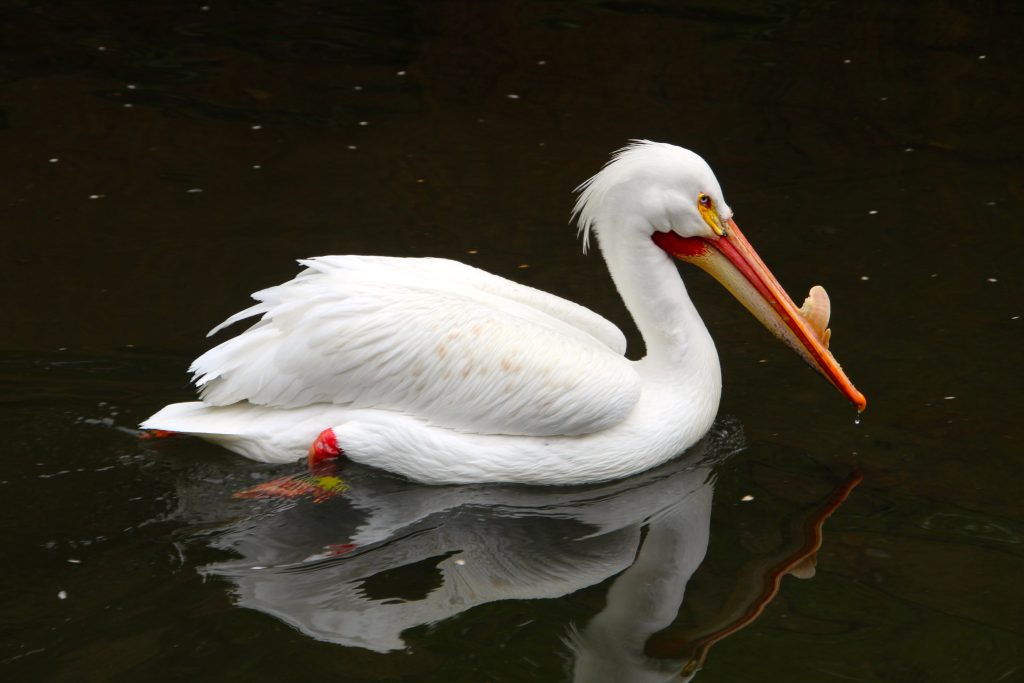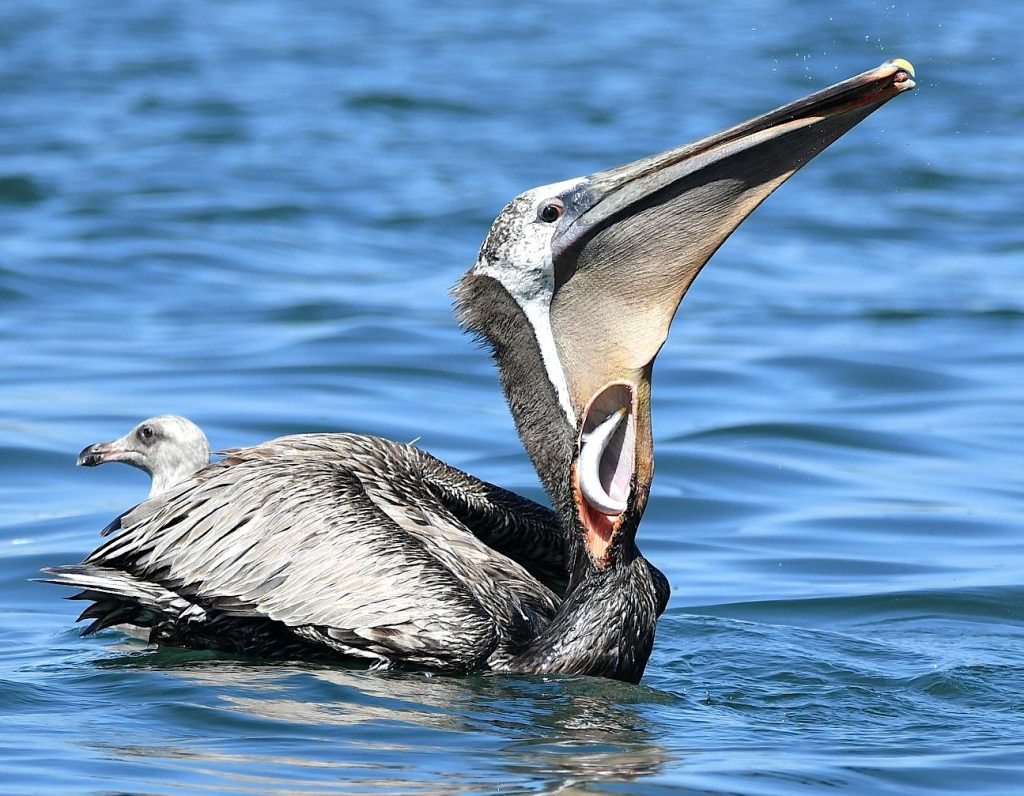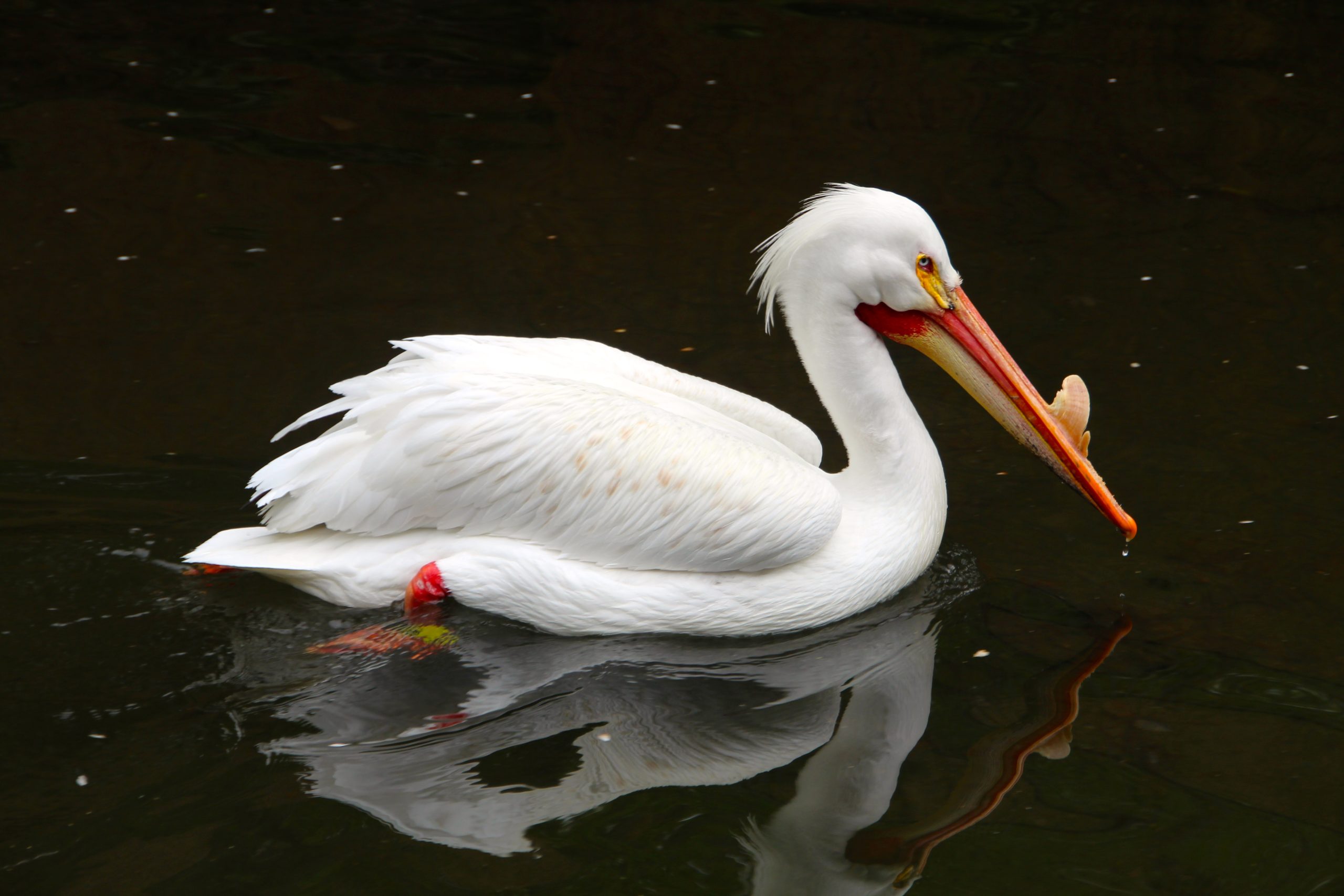In the expanse of North America, one can come across two distinct species of Pelican, both of which grace the landscapes of Nebraska. These avian creatures are none other than the American White Pelican and the Brown Pelican.
During the summertime, one can catch a glimpse of the majestic American White Pelican within the Nebraskan borders. However, the presence of Brown Pelicans in this region is considered a rarity, occurring only by chance and infrequently observed.
Pelicans, characterized by their colossal bills, expandable throat pouches, and sturdy feet, hold the distinction of being among the largest avian species worldwide. Despite their impressive size, these creatures possess a surprising lightness, owing to air-filled cavities within their skeletal structure and skin, enabling effortless floating. Moreover, their elongated wings facilitate graceful soaring during flight.
Within the global avian realm, eight diverse pelican species exist, with two of them claiming North America as their home. These avian inhabitants include the American White Pelican and the Brown Pelican.
During the breeding season, pelicans undergo remarkable transformations, showcasing vibrant hues on their facial skin, throats, and bills, often sprouting additional structures on the latter.
Breeding colonies of pelicans can consist of a staggering 50,000 birds, where the nesting preference, whether ground or tree, varies among species. After approximately 25 days of nest dwelling, the fledglings congregate in “creches,” groups comprising up to a hundred young pelicans, while the doting parents exhibit the remarkable ability to discern their own offspring and solely attend to their nourishment.
Although pelicans engage in predatory behavior, they do not fall under the category of birds of prey, which exclusively encompasses raptors. The dietary preferences of pelicans predominantly revolve around fish, yet they also partake in meals consisting of crabs, frogs, snakes, mammals, other birds, and insects.
Their distinctive throat pouches aid in capturing fish and expelling excess water before swallowing their catch. Furthermore, juvenile pelicans directly feed from the pouches of their parents.
To facilitate the identification of Pelicans present in Nebraska, this guide relies on the avibase database and incorporates data collected by diligent bird watchers on ebird, ensuring the provision of accurate and genuine information regarding the optimal spotting periods for these fascinating avian species.
Two Pelican Species in Nebraska:
American White Pelican

The American White Pelican predominantly frequents Nebraska during the summer season, although their numbers surge during migratory periods from March to April and September to October. On occasion, a few individuals may even linger during the winter months.
According to reports from avian enthusiasts, American White Pelicans have been sighted in 3% of summer checklists and appear on up to 13% of checklists during the spring migration within the state.
These impressive creatures bear the distinction of being large, soaring birds, with the second most extensive average wingspan among North American avifauna.
Non-breeding adult American White Pelicans exhibit a predominantly white plumage, accentuated by black flight feathers that come into view during flight or when their wings are outstretched. Their eyes possess a bluish-gray hue, while their facial skin surrounding the eyes appears yellow. Pale orange hues adorn their bills, pouches, and feet. In contrast, juvenile American White Pelicans boast light gray feathers with darker brown napes.
When in the midst of the breeding season, adult American White Pelicans exhibit a striking transformation in their appearance. While their bodies retain their all-white composition, vibrant orange hues envelop their eyes, bills, legs, and feet. Notably, they develop a yellow plate on their upper bills, resembling a distinctive horn-like structure.
American White Pelicans undergo various molting phases, known as “eclipse.” Springtime sees the emergence of a visible yellowish patch on their breast and chest, while summer heralds the appearance of blackish feathers on their heads.
Pelecanus erythrorhynchos
Length: 60 – 63 in (152 – 160 cm)
Weight: 246.4 oz (6983 g)
Wingspan: 96 – 110 in (244 – 279 cm)
The breeding grounds of American White Pelicans lie in secluded inland lakes across North America. Subsequently, they embark on winter sojourns to the southern Pacific Coast of the United States, the Gulf of Mexico, Mexico, and Central America. During their migratory journey, they can be spotted in various western and central states of the US.
In their quest for habitat, American White Pelicans gravitate toward shallow freshwater lakes, wetlands, as well as the fringes of lakes and rivers. Come wintertime, these elegant beings can be found in coastal bays, inlets, and estuaries, engaging in foraging activities in shallow waters and seeking respite on sandbars.
The primary sustenance for American White Pelicans comprises fish. They navigate the water’s surface, employing their colossal bills to secure their prey. Additionally, they engage in communal foraging, collaborating with other avian species to skillfully drive fish towards the shoreline, enabling effortless acquisition.
Opportunistic in nature, American White Pelicans traverse extensive distances in pursuit of better feeding grounds. Their diet may extend to include crayfish, amphibians, salamanders, and they have been known to pilfer fish from the water’s surface belonging to their avian counterparts.
The vocal repertoire of American White Pelicans primarily consists of silence, with occasional grunts. However, their offspring within the expansive colonies exhibit more vocal enthusiasm, employing squawks as they beseech their parents for nourishment.
The nests of American White Pelicans take the form of rudimentary depressions upon the ground. Additional twigs, sticks, reeds, and assorted materials are added atop the soil to provide protection for their precious eggs.
Upon laying one to two eggs, both parents dutifully engage in joint incubation, ensuring the preservation of their progeny for a period of up to thirty-six days. Regrettably, due to the phenomenon of siblicide, wherein one sibling eliminates the other, only a solitary chick within each nest emerges victorious.
Fun Facts: The remarkable bill of the American White Pelican possesses the capacity to contain an astounding three gallons of water. When procuring fish from the ocean, these magnificent creatures tilt their bills downward to drain away excess water, facilitating the consumption of the remaining piscine morsels confined within their throat sacs.
Brown Pelican

Within the realm of Nebraska, the presence of Brown Pelicans is infrequent, bordering on accidental, with few documented sightings. The most recent observations occurred in the vicinity of Sutherland Reservoir State Recreation Area back in 2015.
Non-breeding adult Brown Pelicans exhibit distinctive features, characterized by white heads and necks, complemented by pale yellow foreheads. Their elongated bills exhibit a fusion of yellow and orange hues. Grayish-brown hues dominate their bodies, while their legs remain short and black, accompanied by webbed feet. Juvenile Brown Pelicans showcase brown plumage on their heads, necks, backs, and wings, accentuated by bluish-gray bills. Underneath, their plumage takes on a light brown shade.
The Brown Pelican boasts five subspecies, with two of them partaking in breeding activities within the confines of the United States. The Pacific Coast variant, known as P.o.californicus, and the Atlantic Coast variant, identified as P.o.carolin
ensis.
Differences between Pacific and Atlantic Brown Pelicans become more pronounced during the breeding season. Both variations exhibit white heads with a more vivid yellow hue on their foreheads. The nape of their necks transitions from white to dark brown. Atlantic Brown Pelicans showcase olive-brown throat pouches, whereas their Pacific counterparts boast red-hued pouches.
- Pelecanus occidentalis
- Length: 48 – 50 in (122 – 127 cm)
- Weight: 131.2 oz (3718 g)
- Wingspan: 78 – 84 in (198 – 213 cm)
Brown Pelicans either engage in breeding and migratory behaviors or reside year-round along the Pacific and Atlantic Coasts of North America, stretching down to northern regions of South America.
Environments characterized by shallow waters serve as favored haunts for Brown Pelicans. They establish permanent residences in estuaries and coastal marine habitats. Resting periods often find them perched on mangrove islets, sandbars, breakwaters, and offshore rocks.
Brown Pelicans possess an exceptional foraging technique that sets them apart. Their ability to plunge into the depths of the ocean allows them to ensnare prey within their capacious throat pouches. Upon resurfacing, they expel water from their pouches, facilitating immediate ingestion of their prized catch.
Their diet primarily revolves around fish species such as sardines and herring. In moments of respite from diving, they engage in casual swimming, swiftly seizing prey with their bills. Their gastronomic inclinations may also encompass crustaceans like prawns, amphibians, eggs, and even young birds.
Adult Brown Pelicans typically maintain a silent demeanor, punctuated sporadically by soft grunts. However, their juvenile counterparts vocalize with fervor, employing squawks as a means of beseeching nourishment from their caretakers.
Nesting habits of Brown Pelicans predominantly involve ground-based construction rather than tree-dwelling. Concealment and protection play key roles, with nests often found on islands, amidst mangroves, or nestled within cliffs. Female Brown Pelicans undertake the construction process, utilizing reeds, leaves, pebbles, sticks, and compacted soil. Each female lays two to four eggs, which are jointly incubated by both parents for approximately a month.
Fun Fact: Brown Pelicans employ their webbed feet to cover and incubate their eggs. However, this practice proved detrimental to the species during a period when the pesticide DDT resulted in the thinning of eggshells. The fragility of the shells made them susceptible to breakage under the weight of their parent’s feet. Significant conservation efforts were required to restore the Brown Pelican population to healthy numbers.
